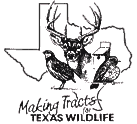Private Lands and Habitat Program
Texas Parks and Wildlife Department (TPWD) provides technical assistance to persons desiring to include wildlife management considerations in present or future land use practices. This service is strictly advisory and is provided without charge to cooperating land managers.
The goal of the Private Lands and Habitat Program is to provide advice and information to land managers for the conservation and development of wildlife habitat and the proper management of the various wildlife populations which utilize that habitat. Through this effort, the Department hopes to slow or reverse the decline in quantity of the State's wildlife habitat and improve the quality of remaining habitat. Biologists of the Texas Parks and Wildlife Department promote management practices which will maximize wildlife potential, prevent waste or depletion of the resource, provide aesthetic and economic benefits to the landowner, and offer increased opportunity for public use and enjoyment of renewable natural resources.
Upon request, a biologist will schedule a personal meeting with the land manager and an inspection of the property. The land manager will be asked to define the various needs and uses of the property and to establish an objective for wildlife considerations. Once the property's potential has been determined and constraints thereon identified, the biologist will provide recommendations which often include a written management plan. Recommendations will focus on increased ecological diversity as required to address habitat needs of wildlife. The process will incorporate planning that benefits a wide variety of wildlife, in concert with management of featured species identified by the land manager. Unique areas will be noted in cooperation with the landowner and management options suggested to enhance or conserve these habitats.
A management plan addresses multiple facets of habitat and population. Components of a management plan include an objective as established by the land manager, the past history of hunting and other land use, and a description and appraisal of the habitat. Specific recommendations are given concerning habitat management practices, wildlife considerations in livestock management, availability of water and wildlife, foods, management of wildlife populations, and harvest of game species. The importance of keeping good records to aid in determining the status of wildlife populations and evaluating management program progress is demonstrated.
Recommendations for habitat management stress the quantity, quality, distribution, and diversity of vegetation necessary to support viable wildlife populations. The relative importance of grasses, forbs (weeds), and woody plants (trees, shrubs, and vines) is explained.
The use of proper harvest as a management tool to maintain game populations in balance with available food supplies is encouraged and explained in detail. Achieving and maintaining desired population parameters such as age structure, production level, and sex ratio is emphasized.
Population management of big game species is often identified as a key tool for habitat management in concert with domestic livestock management and other land use practices. The value of wildlife as a renewable natural resource is explained in economic and aesthetic terms.
Survey techniques are suggested which will adequately monitor population levels and allow the development of game harvest quotas. The merits of various census techniques, their relative accuracy and cost are explained. Participation in survey activities by technical guidance personnel is on a one time basis for demonstration purposes; cooperators are responsible for the performance of subsequent surveys and implementation of management actions.
Wildlife biologists will continue to assist cooperators through periodic visits to help interpret survey information and formulate harvest recommendations. The overall progress of the management program will be assessed and adjustments recommended as appropriate.
